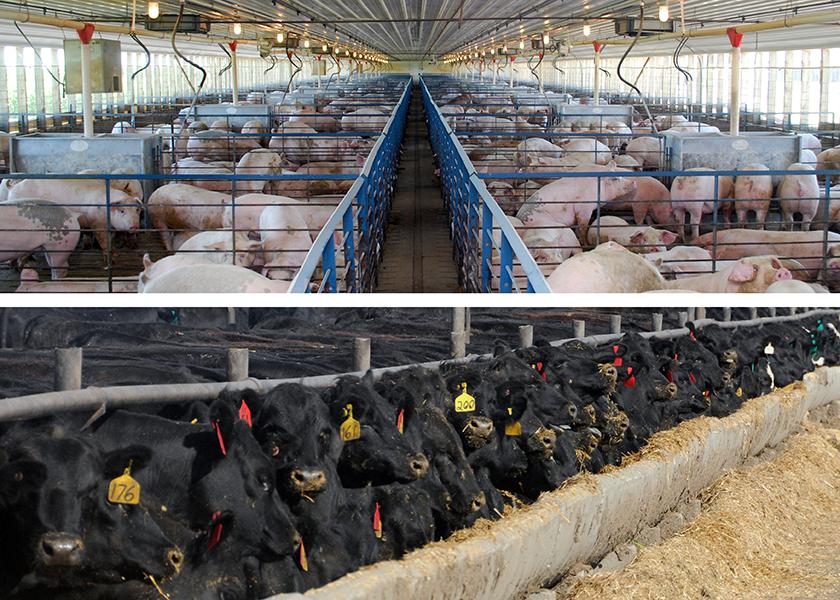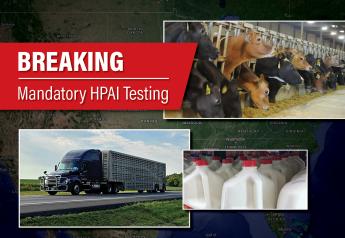Is the Livestock Industry Prepared for a Foreign Animal Disease Outbreak?

Foreign animal diseases (FAD) are a constant threat to the U.S. livestock industry. But the country seems more tuned in to this struggle than ever before with the recent COVID-19 pandemic. National Pork Board’s chief veterinarian Dave Pyburn and National Cattlemen’s Beef Association’s chief executive officer Ethan Lane shared their perspectives during the Coalition for Epi Response, Engagement and Science (CERES) Biosecurity Infectious Disease Symposium at Colorado State University on how prepared the pork and beef industries really are when it comes to the threat of FADs.
Pork Industry Adopts AgView
When African swine fever (ASF) was discovered in China in August 2018 and rocked the global pork industry, the National Pork Board, among others, began looking at ways to increase foreign animal disease preparedness efforts in the U.S. One of the many positive steps forward since then has been the creation of AgView, a voluntary option for producers to keep records on animal movement that could be easily shared with their state veterinarian in the case of a FAD outbreak.
“We wanted to find a way to add to that data that’s currently available to both state and federal animal health officials as they look to respond to a FAD. Not only did we want to help find the disease more quickly and eradicate the disease more quickly, but also get back to some business continuity as quick as we can,” Pyburn said.
After evaluating the current preparedness plans, the National Pork Board decided one area the industry needed to hone in on was pig movement and contact tracing.
“That's the majority of the way that we move animal diseases in our country today – through animal movement,” Pyburn said. “So, we asked ourselves how we could supply real time pig movement data to officials so that they could have the information needed to respond more efficiently and quickly to enable business continuity to whatever degree possible.”
That's where the idea of Ag View came into the picture – creating an opportunity to work hand-in-hand with current systems in place and ultimately help improve that response.
Beef Industry Sees Similar Challenges
Lane said he sees a lot of similarities between what the pork industry is doing and what the beef industry is doing in the area of FAD preparedness.
“I think we're trying to tackle a lot of the same challenges, in accessing that information and interfacing with a lot of different state programs,” Lane said. “The states are all warehousing data in different ways, that's a lot of what cattle trace has been focused on and what our inner NCBA working group has been focusing on.”
Dealing with different views from producers, making sure they are assuaging everyone’s concerns about how information like this can be used to help them and balancing all of this against the need to quickly access information in the event of an outbreak, is a challenge, he explained.
“Whether it’s debating how many different data points are really necessary to quickly get to the right information or how do we ensure the safety and security of that information to some practical challenges on the ground, particularly with cattle movements,” Lane added. “If you look at our Western guys that are using pastures and grazing permits sometimes in different states, a pasture ID versus centering that on a home ranch operation. Those become very important data points to work through and that's been a large part of the focus on our conversation over the past few years.”
Teaming Together
The AgView system could be launched for other livestock species, Pyburn said. Discussions have been underway between the pork and beef industries about how this system could bring other commodities and their information into this same system.
“In the end, what the federal and state animal health officials want is one dashboard to be able to use no matter what that foreign animal disease is,” Pyburn said. “We've got some foreign animal diseases, like foot-and-mouth disease in particular, that will involve both of us so it we’re going to want all of that data in one spot for those folks to respond.”
In addition to teaming together among species, Pyburn said it requires a team effort from producers, too. AgView is 100% voluntary. The nice thing about AgView is that producers can have their current data in the system, and it's only visible to the producer that has entered the data, he said.
“The only time the data goes forward is if we actually have a foreign animal disease outbreak and there's a need for it because the producer is involved in the incident or is within the outbreak area. When that happens, the state or federal animal health officials will request permission from those producers to be able to see it,” Pyburn said.
The producers still have the right to say no and that data will go nowhere. But Pyburn cautioned that may also hamper the animal health official’s ability to get back to some animal movements that would ensure business continuity.
“I think there's going to be some need, or some want on the part of the producer, to be able to supply that data,” he said.
Meanwhile, on the cattle side, Lane said the industry is likely moving into an arena over the next few years where there is going to be a mandatory component for producers that are moving cattle across state lines.
One of the concerns Lane often hears is the cost and the fact that at the end of the day, a lot of the cost will be borne by those producers on the ground.
“We are going to need to have more extensive conversations on Capitol Hill,” Lane said. “We are going to probably be seeking out additional resources to implement a more comprehensive system so that cost isn't being borne solely by the beginning of the supply chain.”
Watch these webinars for more:
Don’t Take Your Eyes Off of African Swine Fever
Technology, Traceability and the Beef Industry of the Future
Read More:
What Happens If? An Answer to the Question Everyone’s Asking
Vilsack Weighs In On Parallel Between COVID-19 and Animal Disease Outbreaks
Ranchers Split on Need for Traceability System
African Swine Fever: Trust Your Instinct, Be Prepared
What Makes Foot-and-Mouth So Infectious?
Tool Helps Develop Custom Biosecurity Plan for Disease Prevention







